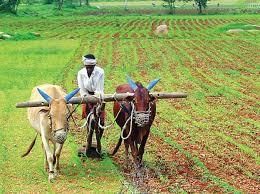GPSC (Goa) Exam > GPSC (Goa) Notes > Goa State PSC (GPSC) Preparation > Goa: Cropping Pattern
Goa: Cropping Pattern | Goa State PSC (GPSC) Preparation - GPSC (Goa) PDF Download
| Table of contents |

|
| Cropping Pattern in Goa |

|
| Agriculture Pattern/Changes issue in Cropping Pattern of Goa |

|
| Goa Crop Combination |

|
| Conclusion |

|
Cropping Pattern in Goa

- Cropping patterns in Goa are primarily influenced by a combination of soil and climatic conditions that create a specific agro-ecological environment suitable for various crops.
- Farmers in the region base their choices on factors such as anticipated productivity and economic returns when selecting crops and cropping systems.
- Decision-making regarding crop selection is further shaped by infrastructure provisions, socio-economic circumstances, and technological advancements at a local level.
Factors Influencing Cropping Patterns
- Soil and Climate: The inherent characteristics of the soil and the prevailing climatic conditions play a key role in determining which crops thrive best in a particular region.
- Farmer Decision-Making: Farmers consider factors like expected yield and financial benefits while deciding on crops to cultivate.
- Infrastructure: Availability of facilities such as irrigation, transportation, storage, trade, marketing, and post-harvest handling influence crop choices.
- Socio-economic Factors: Elements like financial resources, land ownership, size of land holdings, household needs, and labor availability impact cropping decisions.
- Technological Advancements: Factors such as the availability of improved seed varieties, cultural requirements, mechanization, plant protection, and access to information affect crop selection and farming practices.
Agriculture Pattern/Changes issue in Cropping Pattern of Goa

- Agriculture and Forests play a crucial role in maintaining Goa's green cover, spanning about 65% of the region.
- Over the past five decades, significant transformations have occurred in Goan agriculture.
- In 1961, agriculture engaged around 70% of the population, primarily focusing on paddy, cashew, and coconut cultivation.
- Presently, the agricultural landscape has evolved, with cashew cultivation expanding to approximately 55,000 hectares and paddy fields covering about 31,000 hectares.
- Horticultural crops are gaining prominence due to their higher profitability, reduced risks, and suitability for part-time farming.
Government Support and Initiatives
- The State extends various forms of assistance to farmers, ranging from land preparation to marketing their produce.
- The Agriculture Department executes developmental programs across all talukas, maintaining plant production centers, machinery provision centers at the taluka level, and training facilities at the district level.
- Soil testing laboratories at the district level issue soil health cards for major and micronutrients.
Key Agricultural Practices and Trends
- Due to a shortage of manual labor, farmers are increasingly relying on machinery, marking a shift in agricultural practices.
- The average landholding size is small, with nearly 80% of farmers owning less than one hectare of land.
- Goa stands out as a state where farmers are guaranteed prices for their produce, offering support prices for crops like paddy, coconut, arecanut, oil palm, and sugarcane to shield farmers from market price fluctuations.
- Irrigation plays a pivotal role in enhancing agricultural productivity in Goa.
Irrigation Methods and Projects
- Traditional irrigation sources include storage tanks, small diversion bandharas, natural springs, and wells.
- Historically, for rabi paddy cultivation, irrigation primarily relied on storage tanks in Salcete and Bardez.
- Various irrigation methods are employed in different regions, such as small diversion works in Panda, Sanguem, and Bicholim for paddy fields during Rabi.
- A significant portion of arecanut cultivation depends on springs at higher altitudes.
- Post-liberation, the implementation of lift irrigation schemes and well developments, including projects like Selaulim and Anjunem, has expanded the irrigated area by over 10,000 hectares.
Overview of Rice-Rice Cropping Pattern in Goa
- Rice-rice cropping system is widely practiced in irrigated lands within the humid and coastal ecosystems of Goa.
- The sustainability of productivity in this system faces several challenges:
- Deterioration in soil physical conditions.
- Issues related to micronutrient deficiency.
- Poor efficiency in the use of nitrogen.
- Imbalance in nutrient application.
- Lack of suitable transplanters to address labor shortages during critical transplanting periods.
- Proliferation of problematic weeds like Echinochloa crusgalli without effective control measures.
- Additionally, common issues contributing to low productivity include the accumulation of pests, diseases, and weeds over successive seasons, as well as significant soil health degradation.
Question for Goa: Cropping PatternTry yourself: Which factor plays a key role in determining the crops that thrive best in a particular region?View Solution
Goa Crop Combination
Three-Crop Combinations
- Four tehsils in Goa—Tiswadi, Pernem, Sattari, and Ponda—exhibit distinct crop combinations, reflecting the agricultural diversity of the region.
- Rice emerges as the primary crop in Tiswadi, with cashew nut and coconut following suit. Collectively, these crops occupy a significant 86% of the total net sown area in these regions.
- Pernem showcases a substantial dominance of cashew nut cultivation, encompassing about 43% of the area. Cereals, pulses, and oilseeds also hold importance, with rice featuring prominently.
- In Sattari, the terrain favors cashew nut growth, with 58% of the net sown area dedicated to this crop. The hilly Western Ghats terrain with laterite soil is particularly conducive for cashew plantations, while rice is prevalent in the plains along the Mandovi River.
- Within the Ponda tehsil, rice takes precedence, covering 38% of the total cropped area, with cashew nut and coconut following in significance.
- In 2010-11, four out of Goa's 11 tehsils exhibited three crop combinations: Tiswadi, Pernem, Quepem, and Murmugao.
- Tiswadi and Pernem maintained consistent crop combinations and ranking during this period.
- Quepem prominently featured rice as the leading crop, occupying 50% of the total cropped area, trailed by cashew nut and coconut.
- Murmugao stood out with coconut as the primary crop, succeeded by rice and cashew nut in importance.
Four-Crop Combinations
In Sanguem, Cancona, Murmugao, and Quepem, distinct crop combinations were observed.
- Sanguem: Notable crops included cashew nut (40%), rice (24%), coconut (17%), and garden crops (8%).
- Canacona and Quepem: Rice emerged as the primary crop, occupying a significant portion of the total cropped area, followed by cashew nut, coconut, and garden crops.
- Murmugao: Coconut was the most dominant crop, constituting 42% of the share due to favorable geographical conditions. Rice, cashew nut, and cereals, pulses, and oil seeds followed.
- In 2010-11, four crop combinations were observed in Bardez, Ponda, Sanguem, and Canacona.
- Bardez: Noteworthy crops included rice, cashew nut, cereals, pulses, oil seeds, and coconut.
- Ponda, Sanguem, and Canacona: The four main crops were rice, cashew nut, coconut, and garden crops.
Five Crop Combinations in 2006-07
- Two tehsils, Bardez and Bicholim, showcased five crop combinations in 2006-07.
- In Bardez, the primary crops were rice (25.95%), cashew nut (25.87%), cereals, pulses, and oil seeds (21.26%), vegetables (12.23%), and coconut (12%).
- Bicholim highlighted cashew nut as the dominant crop at 48.29% of the total cropped area, followed by rice (23.41%), cereals, pulses, and oil seeds (10.37%), coconut (9.51%), and garden crops (4.13%).
Six Crop Combinations in 2006-07 and 2010-11
- Initially, only Salcete tehsil displayed a six crop combination in 2006-07.
- By 2010-11, two more tehsils, Sattari and Bicholim, adopted this combination.
- These regions cultivated a mix of rice, cashew nut, coconut, groundnut, and vegetables, among others.
- The diverse topography, featuring plain areas along riverbanks and mountainous terrain, facilitated varied farming practices.
- The subsistence farming system in these regions, where farmers grow multiple crops to fulfill family needs, contributed to the presence of six crop combinations.
Conclusion
- The cropping pattern in Goa displays a diverse range of crops, varying from 3 to 6 crop combinations in different years, such as 2006-07 and 2010-11.
- Rice stands out as the predominant crop across the region, serving as a staple food in Goa. With improved irrigation facilities, there is a likelihood of rice expanding its cultivation area and specialization.
- Coconut cultivation could witness an increase in acreage due to the favorable geographical conditions for growth. Moreover, the rising market demand for coconuts as a key ingredient in Goan cuisine may drive this expansion.
- There is a potential for cashew nut cultivation to become a dominant crop owing to its high demand both locally and internationally. However, its production is seasonal, which could impact its share of the total cultivated area.
The document Goa: Cropping Pattern | Goa State PSC (GPSC) Preparation - GPSC (Goa) is a part of the GPSC (Goa) Course Goa State PSC (GPSC) Preparation.
All you need of GPSC (Goa) at this link: GPSC (Goa)
FAQs on Goa: Cropping Pattern - Goa State PSC (GPSC) Preparation - GPSC (Goa)
| 1. What is the cropping pattern in Goa? |  |
Ans. The cropping pattern in Goa includes a variety of crops such as rice, pulses, oilseeds, and vegetables, with rice being the primary crop.
| 2. What is the overview of agriculture in Goa? |  |
Ans. Agriculture in Goa is mainly characterized by small-scale farming, with a focus on rice cultivation and a mix of other crops like pulses and vegetables.
| 3. What is the rice-rice cropping pattern in Goa? |  |
Ans. The rice-rice cropping pattern in Goa refers to the practice of growing two successive crops of rice in the same field in a single year, which is a common practice in the region.
| 4. How are crop combinations analyzed in Goa? |  |
Ans. Crop combinations in Goa are analyzed by looking at the different crops grown together in the same field or rotation, which can vary based on the region and cropping pattern.
| 5. What are the crop combinations in different regions of Goa? |  |
Ans. The crop combinations in different regions of Goa can vary, with some areas focusing on rice cultivation while others may have a mix of pulses, oilseeds, and vegetables in their cropping patterns.
Related Searches














